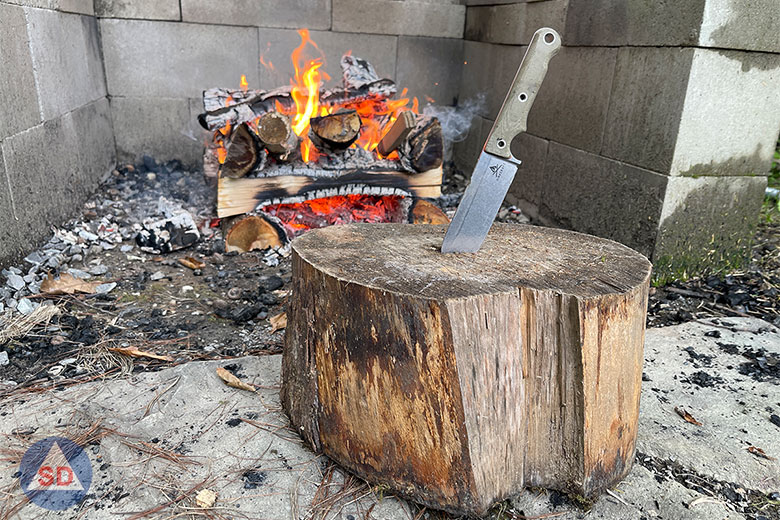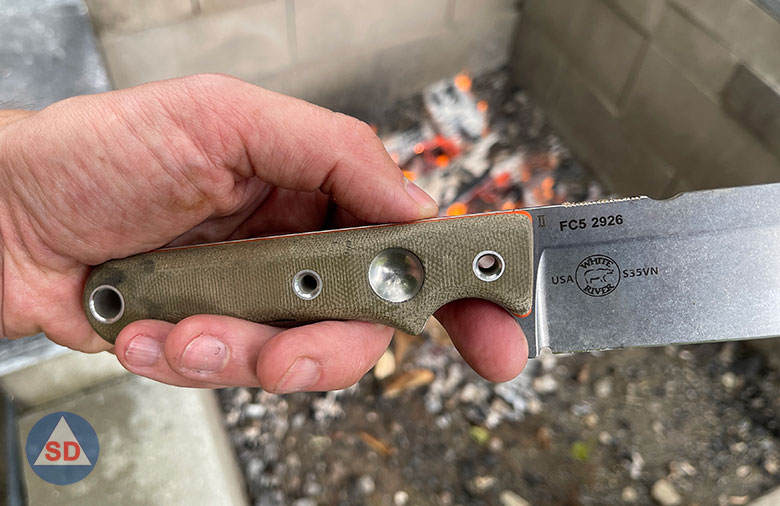In my hunt for the best bushcraft knife, I went to Blade Show and interviewed many knifemakers to get their opinion on what makes a “best” bushcraft knife. While I found one, I realized that many of the attributes I was looking for involved firemaking. Enter the White River Firecraft FC5, a knife made specifically for firemaking.

Why a Knife for Making Fire?
In a survival situation, fire becomes a lifeline. It provides warmth, protection from wildlife, a means to purify water, cook food, and signal for help. Having a dedicated fixed blade knife for firemaking ensures you have a tool optimized for this critical task.
Fire not only provides warmth and safety but can also aid in obtaining other resources like food and water. Preppers should be prepared to use fire as a means of cooking, boiling water for purification, and signaling for rescue.
Owning a dedicated firemaking knife would – hopefully – encourage preppers to practice and develop their bushcraft skills. Proficiency in using the knife and firecraft techniques can be invaluable in a survival situation.
While preppers should have multiple fire starting methods in a bug out bag (firesteel, matches, lighters, etc.), a reliable bushcraft “fire” knife, like the White River Firecraft FC5, ensures they have a manual option when other methods fail.
Rather watch than read? See my YouTube video below.
White River Firecraft FC5 Attributes
For the newbie to knives (I still consider myself a knife neophyte), you might be wondering what qualities make for a good firemaking knife. It’s a question worth asking, because there are sooooo many knives on the market today that it’s hard to sort through them all. A quick survey of the options would lead one to think that they’re all pretty much the same, but when you dig into the details, you find important differences.
Blade Thickness and Grind
Bushcraft knives are known for having thick blades and (often) a Scandi grind. These aspects are better for batoning wood, breaking animal carcasses apart, etc.
The FC5 has a relatively thin (0.158”) blade. A thick is good for whacking at branches and sticks. A thin blade is great for slicing. The FC5 also has a flat grind, adding to the blade’s overall thin appearance.
I find myself preferring a thinner blade when working with fire for a few reasons:
- A thinner blade is better for slicing feather sticks, an important strategy to starting a fire under tough conditions.
- The thinner blade reduces weight and, when possible, I prefer lighter tools, the same as I prefer a lightweight bug out bag.
- If I’m working with a campfire, odds are high I’m cooking with fire. That means meal prep and the need for a kitchen knife. The thinner blade with flat grind is well-suited to sling meat, bread, and vegetables. Using one knife for both firemaking and meal prep makes the entire process easier, particularly when I’m doing it in the field.
- Blade Length: 5 in.; Overall Length: 10 in.; Blade Thickness: 0.158 in.; Knife Weight: 8 ounces.
- Blade Steel: CPM S35VN; Hardness: 58-60 HRC
- Includes Ferro Rod, Kydex Sheath with Leather Dangler, and Ferro Rod Holder
- Canvas Micarta Handles provide comfortable grip in all weather.
- Made in the USA.
That said, you can baton wood with the FC5’s 5″ blade, just know that if you’re buying a knife for heavy batoning, you might want to consider a thicker, heavier blade. Where I am located and where I go, I can usually get by fine without having to baton wood either because I have a small axe or I can easily locate small and medium-sized sticks.
The Steel Itself
Stainless steel doesn’t have the same edge retention as carbon steel, and carbon steel is less expensive. However, I generally prefer stainless because I often take my knife into damp or wet environments where stainless steel performs best.
The Firecraft comes in S35VN stainless, which is a higher quality steel that attempts to blend the qualities of carbon steel with stainless steel. In other words, it’s a stainless steel with much better edge retention. You’ll pay a higher premium for that quality, however.
Choil, Jimping, and Handle
I love the handle on the Firecraft FC5. The green canvas style Micarta handle over orange G-10 liners – nice!
Looks aren’t everything, though. Let’s look at the functionality.
The deep finger choil on the FC5 allows you to work up close when whittling sticks or you need to be precise. It can also act as an indirect safety guard to help prevent your hand from slipping onto the blade if you had to thrust the knife at wild grizzly coming from your campfire salmon.
The same can be said for the knife’s jimping. Setting your thumb on it when thrusting should give you a bit more resistance and it aids in the precise cutting that the choil is designed for. It’s not overly aggressive jimping (I’d actually prefer a bit more), but it does what it’s supposed to do.
The FC5’s handle includes a bow drill divot. I suspect most people aren’t going to be making fires with a bow drill, but if you’re in the business of making fire by all means possible, that will include using a bow drill. The FC5’s bow drill divot is superior to other knives’ divots because it’s wider, deeper, and contains a stainless steel inlay. It is noticeably easier to use the FC5’s divot because the spindle doesn’t fly out as often as it does when using more shallow and narrow divots.

The knife also includes three holes bored through the full tang and handle. This adds to its secondary bushcraft attributes as it allows you to firmly lash the knife to a stick if necessary.
Ferro Rod
The White River Firecraft FC5 (and their other Firecraft series of knives) comes with a ferro rod that fits into the sheath. The handle of the ferro rod matches the handle of the knife (did I mention it’s pretty?).
The notch out on the blade’s spine is designed for striking a ferro rod effectively and efficiently – and boy can this knife throw sparks! If you follow any of my videos on social media you’ll see me using this knife often for starting fires. The spine of the blade is also a sharp 90-degree angle, making that equally suitable for striking a ferro rod.
Sheath
The FC5 comes with a Kydex sheath, as most knives do, but what I particularly like about this sheath is that it includes a dangler and various attachment points. It also has a very slim profile.
The dangler gets the knife out of the way when wearing it in the field and then needing to sit down. The handle of higher-sitting knives of this size will often poke into my side when I get into the truck or sit down in a chair. Not so with the dangler.
Because of the many different holes and slots in the sheath, it can also be strapped to different packs and pouches with ease, adding to its versatility. For the more traditional folks, White River also sells an optional leather sheath.

Firecraft FC5 Specifications
- Blade Length: 5.0″
- Cutting Edge: 5.0″
- Handle Length: 5.0″
- Overall Length: 10.0″
- Blade Material: CPM-S35VN Stainless Steel
- Blade Thickness: 0.158″
- Blade Hardness: 59HRC
- Blade Style: Drop Point
- Blade Grind: Flat
- Blade Finish: Stonewash
- Handle Material: Green Micarta
- Handle Thickness: 0.77″
- Sheath Material: Kydex
- Weight: 8 oz.
- Weight with Sheath: 15.6 oz
- Blade Length: 5 in.; Overall Length: 10 in.; Blade Thickness: 0.158 in.; Knife Weight: 8 ounces.
- Blade Steel: CPM S35VN; Hardness: 58-60 HRC
- Includes Ferro Rod, Kydex Sheath with Leather Dangler, and Ferro Rod Holder
- Canvas Micarta Handles provide comfortable grip in all weather.
- Made in the USA.
Best Firemaking Knife?
Knifemaking technology is constantly advancing, but as it stands right now – from my view – the Firecraft FC5 is the best knife design for making fires.
Is there a better one? Challenge my claim in the comments.

